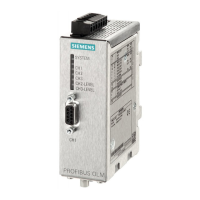Network Topologies
2.1 Introduction
SIMATIC NET PROFIBUS, Optical Link Module
Operating Instructions, 07/2008, A2B00065774O, Edition V1.5
7
3 Network Topologies
3
Which network topologies can be implemented?
The following network topologies can be implemented with the PROFIBUS OLM:
• Point-to-point connection
• Bus (linear) topology
• Star topology
• Redundant optical ring
Combinations of these basic types are also possible. To set up the fiber-optic links
of these network topologies, cables with two optical fibers are used.
If a high degree of availability is required of the fieldbus network, this can be
increased by using a redundant network configuration, for example to allow
continued communication if a cable is broken.
Please note the following:
¾ Single DTEs or complete PROFIBUS segments with a maximum of 31 nodes
can be connected to the electrical interface of the PROFIBUS OLM.
¾ Use only fiber-optic cables in areas subject to heavy noise to avoid EMC
problems affecting the entire network.
¾ Only OLMs of the same wavelength may be connected to each other optically:
– OLM/P11 and OLM/P12 with each other
– OLM/G11 and OLM/G12 as well as OLM/G12 EEC with each other
– OLM/G11-1300 and OLM/G12-1300 with each other
¾ Optical channels connected via fiber-optic cables must be set to the same mode.
¾ Transitions between different OLM types are only possible via the RS-485
interface.
¾ In the network topologies described below, the OLM/G12-EEC can be used
everywhere where an OLM/G12 can be used.

